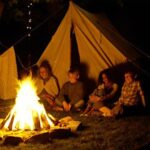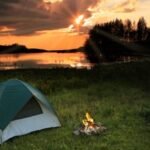by Liz Childers
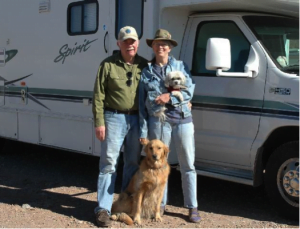
In 1994, Fred and Suzi Dow discovered that very little information was available about the National Forests and National Grasslands. Within a few months, they had received the US Forest Service’s blessing to fix this problem. Packed into their travel trailer, the Dows hit the road to collect information on National Forest campgrounds in order to upload it to a website for the public; later, the National Grasslands were added to this project.
Today, the Dows are the only people to have visited every National Forest with developed campgrounds, and the U.S. National Campground Guide is proof of their project’s success. The site lists all of the campgrounds in the National Forests and Grasslands, where the Dows have visited, with up to 57 points of data, plus narrative comments.
When Lost in the Woods wanted to know more information about camping in the National Grasslands and Forests, we, of course, turned to the Dows. While at a campsite with full hookups in Chadron, NE, Fred and Suzi took a break from their project to share some of their knowledge and experience with us.
The National Forests and Grasslands are “public land, held and managed for the American people,” Suzi said. They are run for “multi-use,” meaning they can be used for all forms of outdoor recreation.
The obvious difference between forests and grasslands is cosmetic. As Suzi put it, they are distinguished by “lots of trees versus few trees, mountains versus rolling hills,” respectively. However, the history behind the two is also significant and helps to draw a further distinction.
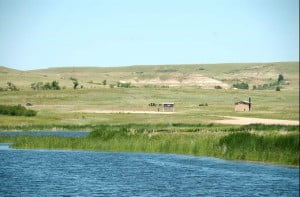
Bass Lake Loop, as seen across Sather Lake in North Dakota’s Little Missouri National Grassland
“National Forests west of the Mississippi River were established as ‘Timber Reserves’ more than 100 years ago. National Forests east of the Mississippi River were generally established from land the government ‘took’ or ‘bought’ from private owners during the early 20th century,” Suzi explained. “Likewise, National Grasslands were established after the Great Depression and Dust Bowl era from damaged lands as soil conservation holdings and given to the Forest Service in the mid-1950s to manage.”
The Forest Service is an agency of the U.S. Department of Agriculture. Therefore, the purpose for these newly acquired lands was development of the grasslands’ grass and the forests’ trees. While the forests had been “abused and non-productive,” they were in far better shape than the decimated grasslands. The grasslands, obviously, had been mismanaged, allowing the soil to blow away in the Dust Bowl of the 1930s.
“National Grasslands are an outstanding conservation success story. Building on lessons from managing National Forests, progressive practices have been advocated by the Forest Service in arid prairie country and have provided a land where grass, water, and wildlife habitat works for both public and private concerns,” Suzi continued. “Did you realize at the turn of the 21st century, conditions were worse than those that produced the Dust Bowl? But we haven’t heard similar reports of destruction and disaster probably because of the agriculture practices advocated by the Forest Service. Just one trip around a national grassland and you’ll see the success.”
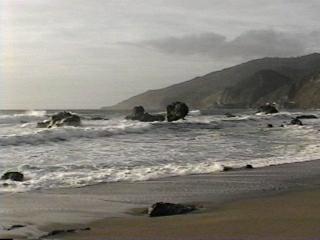
View of the beach near Kirk Creek Campground in California’s Los Padres National Forest.
For you, the camper, there’s another difference. There are only a few developed campgrounds in the National Grasslands; this makes dispersed camping the primary type available to campers. While trails are also few, the Dows say you can travel by foot or horse to camp pretty much anywhere. In contrast, designated trails and developed campgrounds are widely available to National Forest visitors.
The Dows warn that camping in National Forests and Grasslands can be “habit-forming,” in a good way, of course. These campgrounds are a change from the frequently congested campgrounds of private and national parks. You be able to enjoy spacious campsites with a fire pit or grill, a picnic table, and a parking apron, amenities that all developed campgrounds have. Plus, the wide varieties of campgrounds, which range from full hook-ups and hot showers to sites 50 miles down a dirt road with no access to potable water, mean you can find whatever camping experience you want.
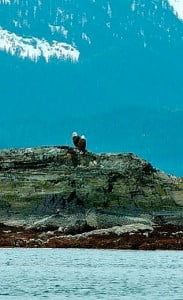
A pair of Bald Eagles in the Lynn Channel in Alaska’s Tongass National Forest
Suzi passed along this list of the top questions they receive from potential National Forest or Grassland visitors: when does the campground open/close; is there safe drinking water/hot showers/flush toilets and such; is the access road(s) safe for my RV; what to do while at the campground; will my RV fit (size of parking aprons, condition of interior road, any low-handing branches, etc.); where can RV holding tanks be dumped; are there any fire bans; can I make a reservation; are reservations necessary; can I bring my dog; and, how do I get to the campground?
On their site, the Dows’ answer these questions and any others you might have specifically for each campground. Now in the 17th year of their project, they are working to return to each campground and update the information. The Dows love hearing from fellow campers, so let them know if you’re discovering the wonderful natural treasures or even if you have updated information about a campsite.
October 7, 2011
Liz Childers
Uncategorized

